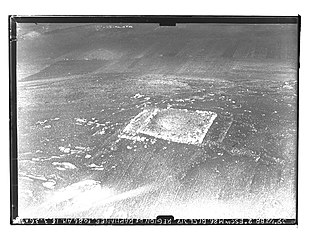Related Research Articles

Alexandria Troas is the site of an ancient Greek city situated on the Aegean Sea near the northern tip of Turkey's western coast, the area known historically as Troad, a little south of Tenedos. It is located southeast of modern Dalyan, a village in the Ezine district of Çanakkale Province. The site sprawls over an estimated 400 hectares ; among the few structures remaining today are a ruined bath, an odeon, a theatre, gymnasium complex and a recently uncovered stadion. The circuit of the old walls can still be traced.
Paralus was a historical settlement located at one of the seven mouths of the Nile, Egypt known as Paralus or Sebennys. During Byzantine times it was located in the province of Ægyptus Secunda. The place, mentioned in the Notitia Episcopatuum, has been abandoned and is now covered with the waters of Lake Burullus.
Ibora was a city in the late Roman province of Helenopontus, which became a Christian bishopric. It is now called İverönü, Erbaa in present-day Tokat Province, Turkey. This is stated also by the Annuario Pontificio, which lists the bishopric as a titular see.
Irenopolis or Eirenoupolis was an ancient and medieval city in Roman and Byzantine era Isauria.
The Notitiae Episcopatuum are official documents that furnish Eastern countries the list and hierarchical rank of the metropolitan and suffragan bishoprics of a church.
Scillium is an ancient city in the Roman province of Africa Proconsularis, Scillium must not be confounded with Silli, or Sililli, in Numidia, the situation of which is unknown nor, as Battandier does, identified with Kasrin, which is Cillium, a see of Byzantium. Its episcopal see was a suffragan of the see of Carthage, capital of the province.
Paltus or Paltos is a ruined city. It was also a bishopric, a suffragan of Seleucia Pieria in the Roman province of Syria Prima, that, no longer being a residential see, is included in the Catholic Church's list of titular sees.

Barbalissos was a city in the Roman province of Euphratensis. Its site is marked by the ruins at Qala'at Balis, which partly retains the old name, south of Maskanah, in modern Syria, on the road from Aleppo to the site of Sura, where the Euphrates turns suddenly to the east.
Nawa is a city in Syria, administratively belonging to the Daraa Governorate. It has an altitude of 568 meters (1,864 ft). It had a population of 59,170 in 2007, making it the 28th largest city per geographical entity in Syria.

The Metropolis of Patras is a metropolitan see of the Church of Greece in the city of Patras in Achaea, Greece. The see traces its origins to its patron saint, Saint Andrew, in the 1st century. Historically, it has been one of the two pre-eminent sees of the Peloponnese along with the See of Corinth. The see has been part of the Greek Orthodox Church, except for the period where the city was part of the Principality of Achaea and a Latin see was installed.

Mosynopolis, of which only ruins now remain in Greek Thrace, was a city in the Roman province of Rhodope, which was known until the 9th century as Maximianopolis (Μαξιμιανούπολις) or, to distinguish it from other cities of the same name, as Maximianopolis in Rhodope.
Polybotus or Polybotos was a city in the Roman province of Phrygia Salutaris. Its site is located 3 miles (4.8 km) southwest of Bolvadin in Asiatic Turkey.
Marcopolis was a city in the late Roman province of Osrhoene. It is described at the beginning of the 7th century by the geographer George of Cyprus.
Hephæstus was a town in Roman Egypt, in the province of Augustamnica Prima, the eastern part of the Nile Delta.

Raphanea or Raphaneae was a city of the late Roman province of Syria Secunda. Its bishopric was a suffragan of Apamea.
Hurbayt is a town in Sharqia Governorate of Egypt.
Maximianopolis was an ancient city in Palaestina Secunda, within the Byzantine Empire. The name Maximianopolis was given to it by Diocletian, in honour of his co-emperor Maximian. It was located 17 M.P. from Caesarea and 10 M.P. from Jezreel. The town earlier bore the names Legio and Caporcotani.

Zama, also known as Xama, is in what is now Tunisia and is best known for its connection with what is called the Battle of Zama in which on 19 October 202 BC, Scipio Africanus defeated Hannibal, which ended the Second Punic War with victory for the Roman Republic and broke the power of Ancient Carthage.
Zenopolis was an ancient Roman and Byzantine city in Isauria. Its site is located near Elmayurdu in Asiatic Turkey.
Zenopolis was an ancient Roman and Byzantine city and episcopal see variously placed in Lycia or in neighbouring Pamphylia.
References
- ↑ Annuario Pontificio 2013 (Libreria Editrice Vaticana, 2013, ISBN 978-88-209-9070-1), p. 996
- ↑ Siméon Vailhé, "Tricomia" in Catholic Encyclopedia (New York 1912)
- ↑ Oriens Christianus, III, 677.
- ↑ Patrologia Graeca , XCVII, 236.